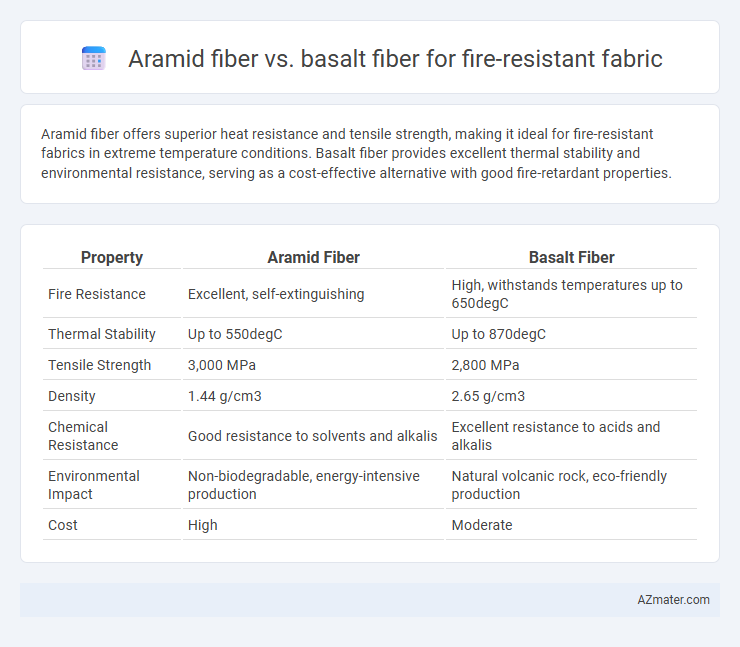Aramid fiber offers superior heat resistance and tensile strength, making it ideal for fire-resistant fabrics in extreme temperature conditions. Basalt fiber provides excellent thermal stability and environmental resistance, serving as a cost-effective alternative with good fire-retardant properties.
Table of Comparison
| Property | Aramid Fiber | Basalt Fiber |
|---|---|---|
| Fire Resistance | Excellent, self-extinguishing | High, withstands temperatures up to 650degC |
| Thermal Stability | Up to 550degC | Up to 870degC |
| Tensile Strength | 3,000 MPa | 2,800 MPa |
| Density | 1.44 g/cm3 | 2.65 g/cm3 |
| Chemical Resistance | Good resistance to solvents and alkalis | Excellent resistance to acids and alkalis |
| Environmental Impact | Non-biodegradable, energy-intensive production | Natural volcanic rock, eco-friendly production |
| Cost | High | Moderate |
Introduction to Fire-Resistant Fabrics
Fire-resistant fabrics rely heavily on materials like aramid fiber and basalt fiber due to their exceptional thermal stability and flame-retardant properties. Aramid fibers, such as Nomex and Kevlar, offer high tensile strength and resistance to heat degradation, making them ideal for protective clothing and industrial applications. Basalt fiber, derived from volcanic rock, provides superior fire resistance and chemical durability, offering an eco-friendly alternative with excellent mechanical properties for fire-safe textiles.
What is Aramid Fiber?
Aramid fiber is a synthetic fiber known for its exceptional heat resistance and strength, commonly used in fire-resistant fabrics for protective clothing and industrial applications. It offers superior thermal stability, maintaining integrity at temperatures up to 500degC, making it ideal for firefighters and military personnel. Compared to basalt fiber, aramid fibers provide better flexibility and durability under prolonged exposure to high temperatures.
What is Basalt Fiber?
Basalt fiber, derived from natural volcanic basalt rock through a high-temperature melting process, offers exceptional fire-resistant properties ideal for protective fabrics. Unlike aramid fiber, which is synthetic and chemical-based, basalt fiber maintains high thermal stability without melting or releasing toxic fumes when exposed to extreme heat. This sustainable material combines durability and eco-friendliness, making basalt fiber a superior choice for fire-resistant textile applications.
Fire Resistance Properties: Aramid vs Basalt
Aramid fibers exhibit exceptional fire resistance, maintaining structural integrity at temperatures up to 500degC while providing inherent flame retardancy and low heat release. Basalt fibers can withstand even higher temperatures, up to 800-1000degC, without melting or releasing toxic gases, making them highly suitable for extreme fire resistance applications. Fire-resistant fabrics utilizing basalt fibers typically offer superior thermal insulation and durability in prolonged high-heat exposure compared to aramid-based fabrics.
Thermal Stability Comparison
Aramid fiber exhibits exceptional thermal stability with a decomposition temperature above 400degC, making it highly effective for fire-resistant fabric applications. Basalt fiber also demonstrates impressive thermal resistance, maintaining structural integrity up to approximately 600degC, surpassing aramid in temperature endurance. The higher thermal decomposition point of basalt fiber provides enhanced performance in extreme heat environments, while aramid fibers offer superior flexibility and impact resistance in fire retardant textiles.
Mechanical Strength and Durability
Aramid fibers exhibit superior mechanical strength with tensile strengths up to 3,600 MPa, making them highly effective in fire-resistant fabric applications requiring durability under stress. Basalt fibers offer excellent thermal stability and are highly resistant to chemical degradation, contributing to long-term durability in harsh fire-exposure environments. When prioritizing mechanical strength, aramid fibers outperform basalt fibers, but basalt fibers provide enhanced environmental resistance for sustained durability.
Chemical Resistance in Extreme Environments
Aramid fiber exhibits superior chemical resistance in extreme environments, maintaining structural integrity when exposed to strong acids, alkalis, and solvents, making it ideal for fire-resistant fabrics in harsh industrial settings. Basalt fiber offers commendable resistance to alkaline substances and maintains stability under prolonged chemical exposure but is slightly less effective against strong acids compared to aramid. The choice between these fibers depends on the specific chemical exposure anticipated, with aramid favored for highly aggressive chemical environments and basalt preferred for moderate chemical resistance combined with environmental durability.
Cost and Availability
Aramid fiber is widely recognized for its superior fire resistance and high tensile strength but comes with a higher cost and limited availability due to complex manufacturing processes. Basalt fiber offers a more cost-effective alternative with abundant natural raw materials, resulting in greater availability and lower price points, though it generally has lower thermal resistance than aramid. For large-scale fire-resistant fabric production, basalt fiber presents an economical choice, while aramid fiber remains preferred for critical applications requiring enhanced fire performance.
Applications in Fire-Resistant Textiles
Aramid fiber exhibits exceptional thermal stability and flame resistance, making it ideal for fire-resistant textiles used in firefighting gear, military apparel, and industrial safety clothing. Basalt fiber offers high temperature resistance and environmental durability, suitable for protective fabrics in heat insulation, welding blankets, and automotive fire shields. Both fibers enhance fire-resistant textiles through superior mechanical strength and heat endurance, with aramid favored for flexibility and basalt for eco-friendly performance.
Choosing the Right Fiber: Aramid or Basalt?
Aramid fiber offers exceptional flame resistance and thermal stability, making it ideal for fire-resistant fabrics requiring high strength and durability in extreme heat conditions. Basalt fiber provides natural fire retardancy, excellent thermal insulation, and superior resistance to chemical degradation, suitable for applications demanding eco-friendly and non-toxic materials. Selecting between aramid and basalt fibers depends on specific fire protection needs, weight considerations, and environmental impact priorities.

Infographic: Aramid fiber vs Basalt fiber for Fire-resistant fabric
 azmater.com
azmater.com